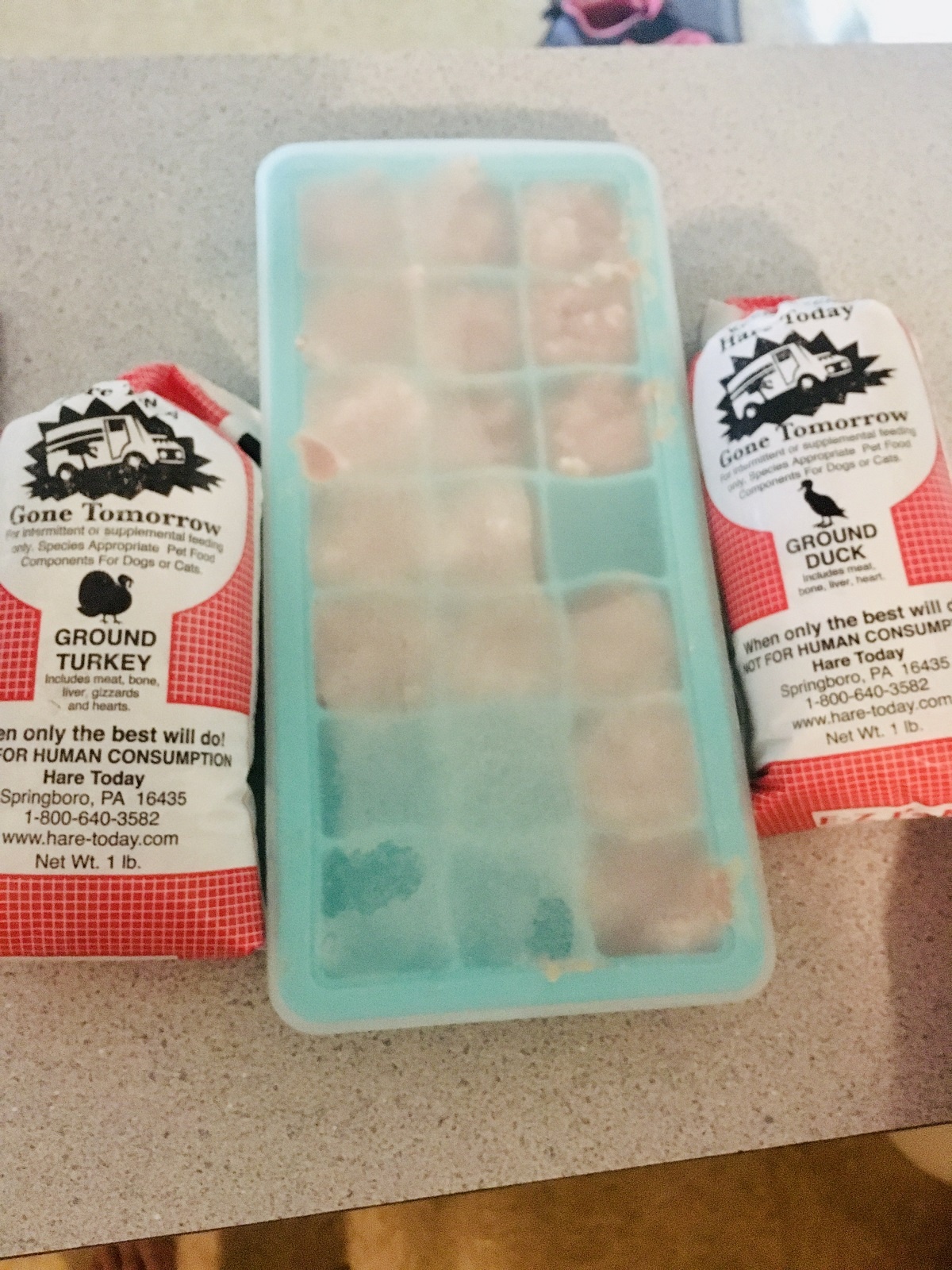A BARF diet for cats is biologically-appropriate raw food that provides the ultimate nutrition.
Most commercial cat food is of poor quality and nutrition.
But according to integrative veterinarians and scientific studies, a BARF diet can help cats shed unwanted weight, prevent disease, and provide the nutrition your cat needs.
Cats that eat dry food only are typically overweight, obese, and/or require medication daily.
There are a lot of myths surrounding the BARF diet for cats.
Let’s take a look at the pros and cons mentioned in scientific studies and veterinarian experience.
So you can feed your cat a BARF diet safely.
BARF diet for cats pros and cons:
- Majority of cats are overweight and eat kibble
- Holistic vets say BARF diet can help resolve health issues
- Raw food diets can increase digestibility
- High moisture food may help cats lose weight
- Human health risks may be present with BARF diets but also with kibble
- Cat owners do not consider BARF diets a health risk
- Nutritional imbalances are possible with BARF diets
- Variety of meat sources is necessary for BARF diets
- Salmonella associated with BARF diets
PS – If you’re ready to switch to a healthy raw diet, my Raw Feeding Blueprint is for you!
I’ve created the most supportive plan inside this course! Think, every week is planned out for you with printable trackers, 50+ balanced recipes to choose from, meal prep hacks, and so much more. If you’re ready to make your cat’s raw food at home, my Raw Feeding Blueprint course is for you!
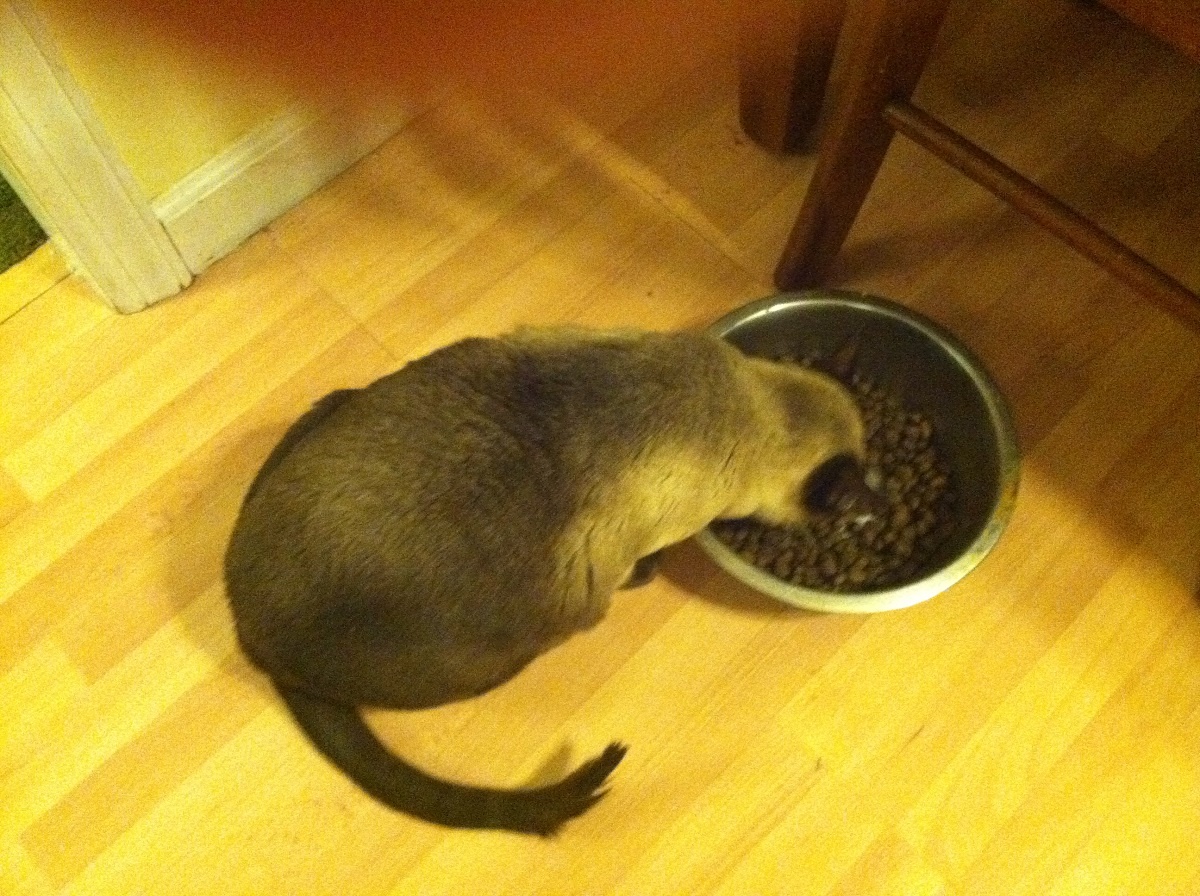
Disclaimer: You (and only you) are responsible for your cats. I earn a commission through affiliate links below. No additional cost to you.
Majority of cats are overweight and eat kibble
The Association for Pet Obesity Prevention has conducted surveys in the US since 2007.
2019 data found that 59.5% of cats in the US are overweight and obese.
They also found that 82% of cat parents feed dry food only either exclusively or most of the time.
And BARF diets were “never” fed to over 88% of cats.
These stats may not prove that BARF diets are healthier for cats.
However, it does prove that kibble is making our cats overweight and obese.
Overweight cats are at a higher risk for:
- Diabetes
- Respiratory issues
- Cancer
- Fatty liver disease
- FLUTD
- Dehydration
- Shortened lives!!!
These serious health issues are too large to ignore.
When asked if BARF diets are healthier than commercial pet foods, 41.9% of cat owners (9.3% veterinary professionals) answered “I don’t know.”
This proves that more research needs to be done on BARF diets for cats.
Holistic vets say BARF diet can help resolve health issues
Many holistic vets recommend a BARF diet for cats.
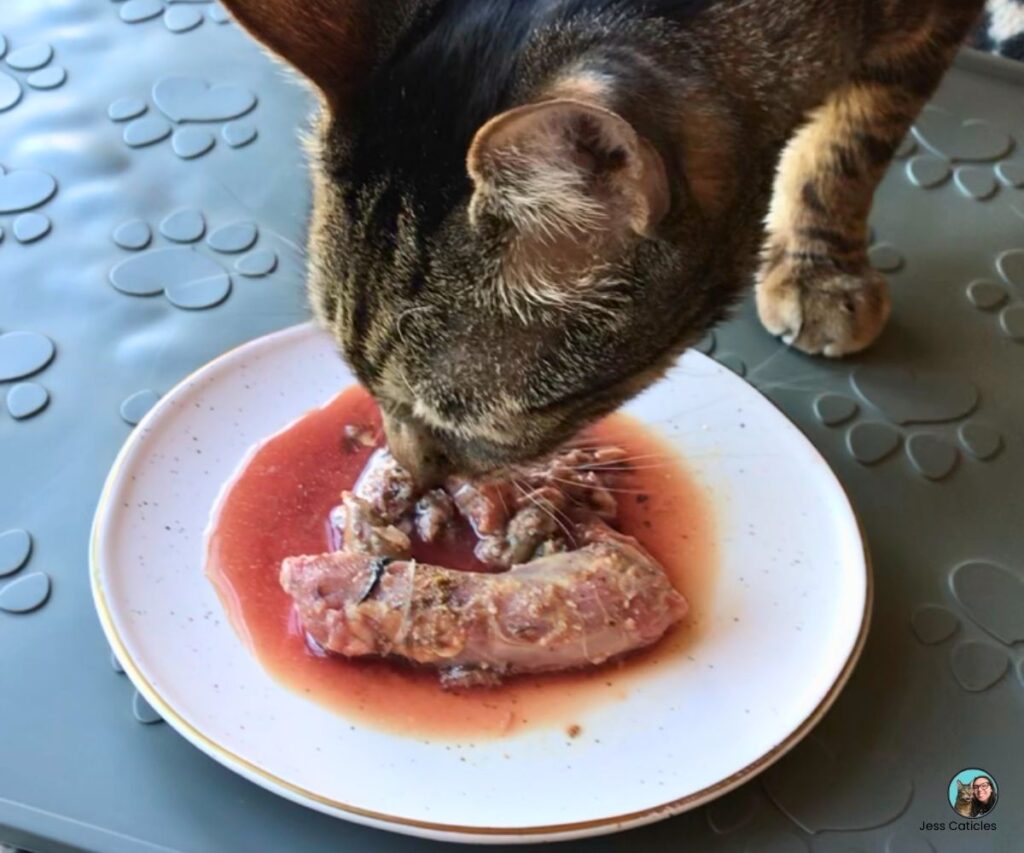
Here are a few examples.
Dr. Andrea Tasi
Andrea Tasi, VMD of Just Cats, Naturally has had a lot of success resolving health issues in cats using BARF diets.
In an interview with Conscious Cat, Dr. Tasi says, “I now recommend raw diets to virtually all my clients, and have seen wonderful improvements in my patients’ health…
I will never go back to recommending or using processed pet foods.”
Heath problems she’s helped improve or completely resolve with BARF diets:
- Diabetes
- Asthma
- Lower urinary tract (bladder) problems
- Chronic vomiting and/or diarrhea (IBD-type symptoms)
- Skin and ear problems
- Other health issues
It appears a BARF diet can help resolve obesity-related health issues.
Dr. Tasi says, “Every cat will respond in their own way, but I now view real, fresh, raw food as the ‘best medicine’ for many of my patients.”
Isn’t that so refreshing? These veterinarians see diet as the foundation of health!
Dr. Deneen Fasano
Dr. Deneen Fasano of Animal Healing Solutions and Pawromatherapy practices acupuncture, chiropractic, herbal medicine, traditional Chinese medicine, diet, and nutrition.
She says, “High carbohydrate diets are the main cause of diabetes and obesity in cats, and this is completely preventable…
I also believe that high carbohydrate diets, especially dry food diets, contribute to most of the chronic diseases in cats, such as kidney disease, hyperthyroidism, diabetes, bladder disease (cystitis), and inflammatory bowel disease and many others.”
Dental disease is another serious health issue for cats. 70-80% of cats have some form of dental disease by the age of 3.
Dr. Fasano says that raw gizzards can be excellent for cat dental health.
Dr. Karen Becker
Dr. Karen Becker of Healthy Pets is a huge advocate for home-prepared balanced BARF diets and a proactive and integrative wellness veterinarian.
She states, “Pets need unadulterated, fresh, whole foods that are moisture dense. They don’t need grains, fillers, artificial preservatives, colors, additives, chemicals, byproducts or processed foods…
Although animals can eat some processed foods, they aren’t designed to consume a lifetime of dry or canned diets.”
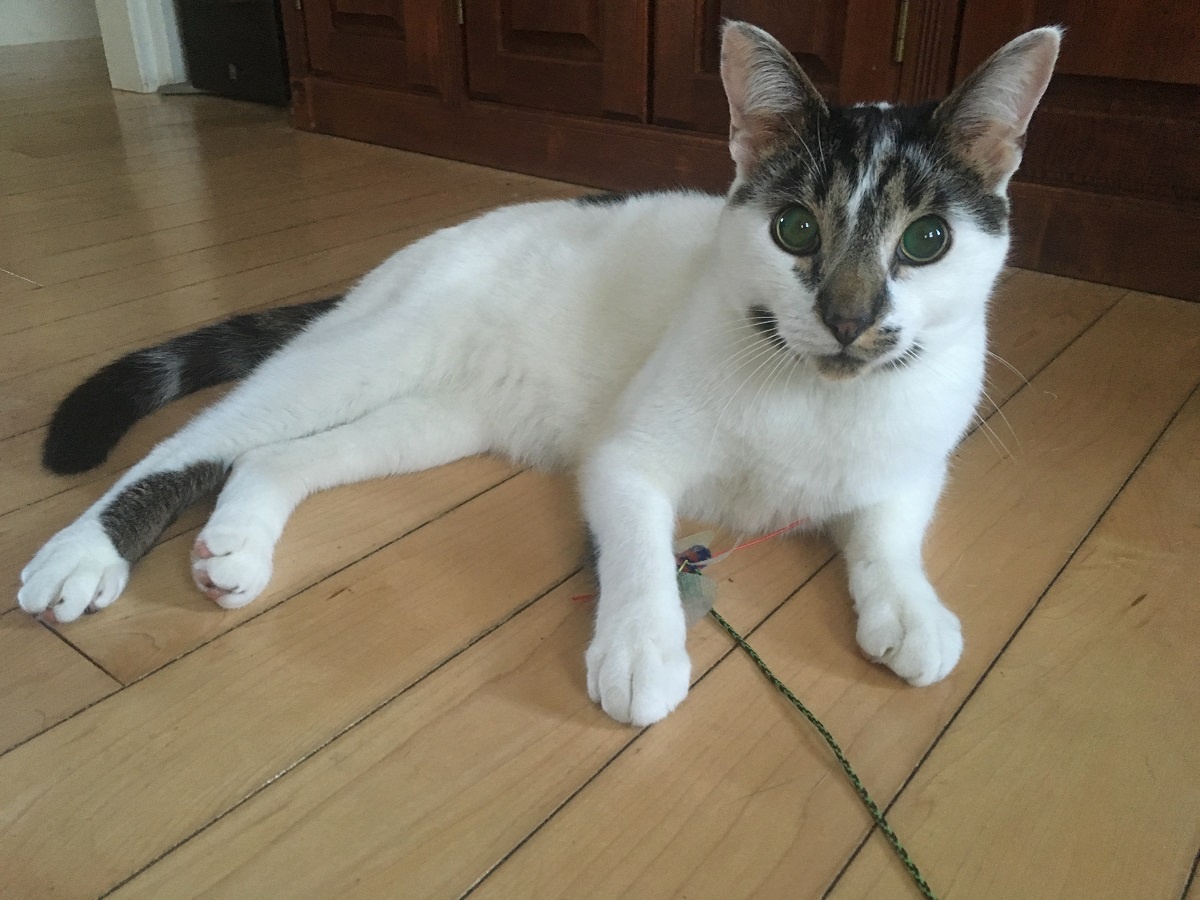
Dr. Lisa Pierson
Dr. Lisa Pierson of Cat Info is another veterinarian advocate for balanced home-prepared BARF diets.
She states, “I have not fed any dry food to my cats for 14 years and I can’t imagine ever feeding my cats this type of diet again…
Cats do not need, or benefit from, any dry food in their diet.”
Her website has an abundance of information regarding diet and health issues.
- “Water” is the most important word when considering urinary tract health
- Many diabetic cats cease needing insulin or have their insulin needs significantly decrease once their dietary carbohydrate level is lowered to a more species-appropriate level
- Dry food is too high in carbohydrates which alters the blood sugar balance in many cats and contributes to obesity
- Soy in cat food is a known disruptor of thyroid gland function
Raw food diets can increase digestibility
Dry food cannot be processed without starch and carbohydrates.
Cats cannot digest these ingredients easily. This causes many health issues.
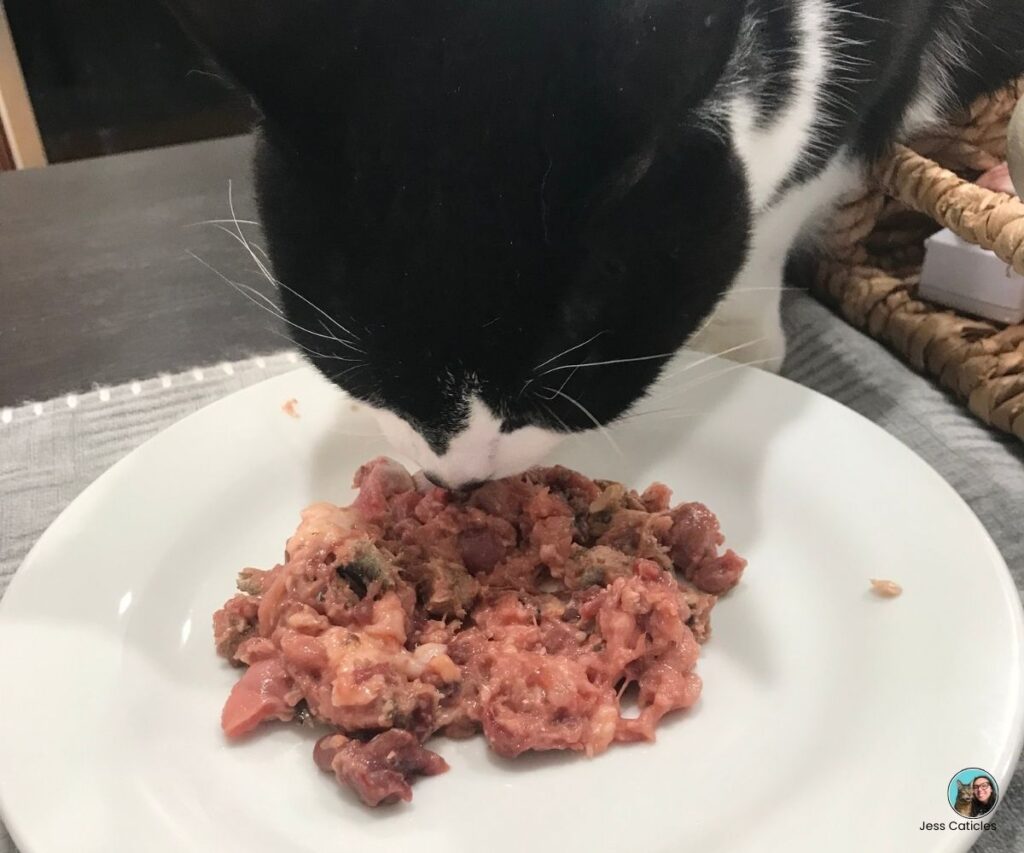
BARF diets for cats, however, are much easier to digest.
Dr. Elizabeth Hodgkins states on Feline Nutrition Foundation, “I have never seen a single case of serious obesity, diabetes, urinary tract disease, or IBD in a cat fed meat instead of commercial dry foods…
The incidence of these problems has not just declined on a raw-meat diet, they have entirely disappeared. These results are too dramatic to ignore.”
Kibble is bad for digestibility:
- Low moisture content
- High in carbs
- Packed with plant protein
BARF diets are the complete opposite of kibble.
You may also check out Dr. Hodgkins’ book Your Cat: Simple New Secrets to a Longer, Stronger Life and her patent in which she treats diabetic patients by switching from dry food to high-protein, low-carb wet food. Please work with your veterinarian on this. You will have to adjust insulin levels according to your cat’s blood glucose.
One study, Nutritional Adequacy and Performance of Raw Food Diets in Kittens found “The raw food diets were associated with higher digestibility and decreased fecal matter.”
This study also states, “There was neither an advantage nor disadvantage of the two raw feline diets when compared with the commercial heat-processed, control diet”.
But better digestibility sounds like an advantage to me.
Especially considering that vomit, diarrhea, and urinary tract issues are so common in cats fed a kibble-only diet.
High moisture food may help cats lose weight
I mentioned above that more than half the cats in the US are overweight and obese.
Obesity leads to serious health issues.
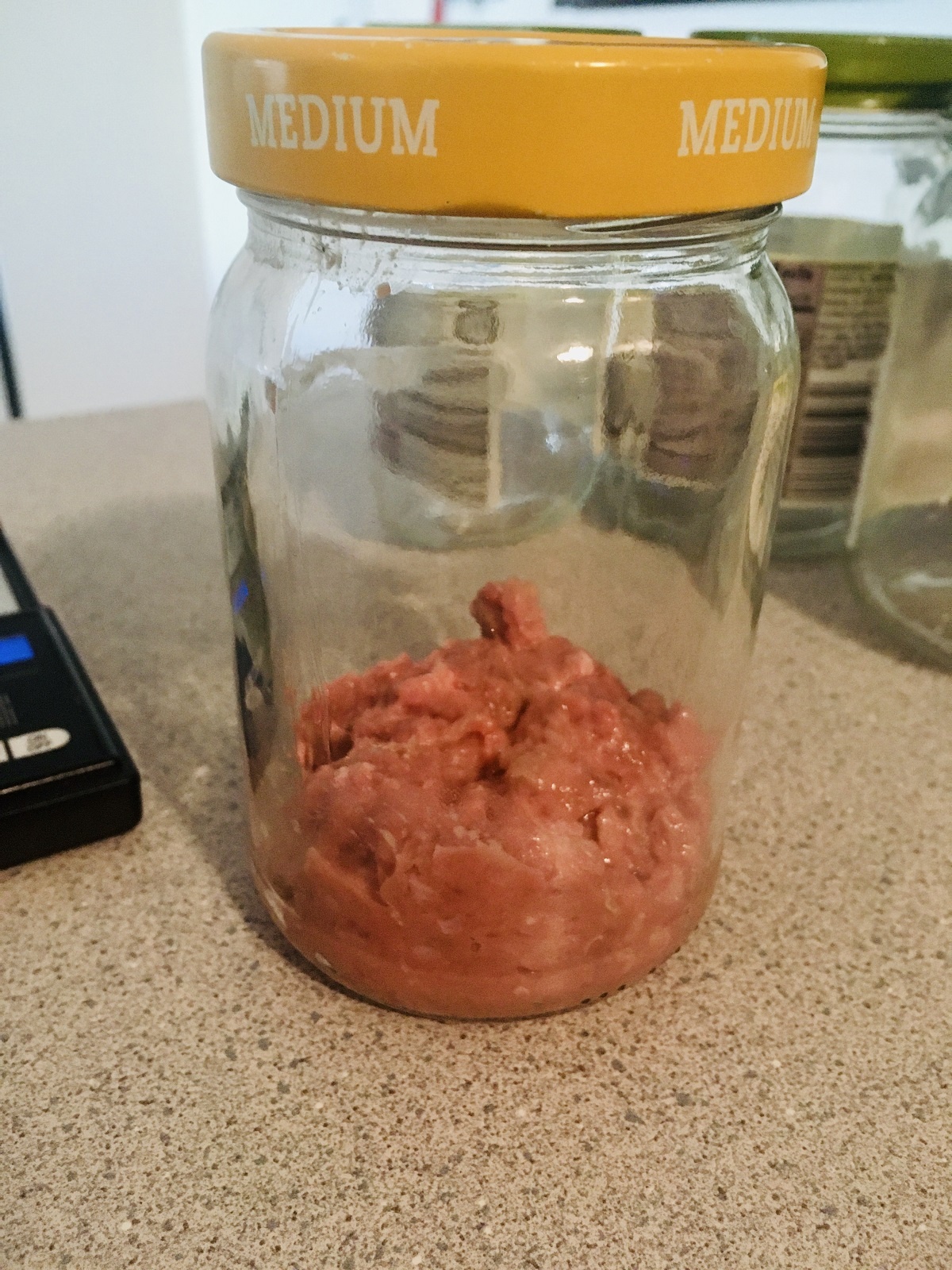
One study by the American Journal of Veterinary Research found “The impact of water content on energy density and food consumption may help promote weight loss in cats.”
This study focused on wet canned food and not a BARF diet.
But the lesson remains the same. Kibble is too low in moisture. BARF diets are high in moisture.
High moisture food is healthier for cats.
Human health risks may be present with BARF diets but also with kibble
BARF bacteria risks
Health risks associated with bacteria and pathogens are the most popular objections and cons for BARF diets.
I’m sure the first thing your vet will say is “raw diets are dangerous because of Salmonella.”
A critical review by NCBI cites many instances where bacteria do affect human and cat health.
However, the abstract states, “Although there is a lack of large cohort studies to evaluate risk or benefit of raw meat diets fed to pets, there is enough evidence to compel veterinarians to discuss human health implications of these diets with owners.”
So it is not your veterinarian’s responsibility to say that raw foods are dangerous.
Instead, your veterinarian should speak to you about proper handling, feeding, and storing of raw diets.
This review is from 2011. BARF diets are much more popular now.
So there is more information available about safety precautions.
For example, Frontiers in Veterinary Science found that there is a low pathogen contamination risk.
We conclude that potential or probable cases of pathogen transmission is likely dependent upon hygiene and food safety measures, and more education surrounding food safety should reduce risk.
Frontiers in Veterinary Science.
Additionally, the survey concluded that pathogen risk was decreased when pet parents only fed raw.
And pathogen risk was increased when pet parents mixed raw with kibble.
Kibble bacteria risks
There was an investigation over a three-year period on Salmonella outbreaks primarily affecting young children.
This investigation led to more than 23,000 tons of dry pet food recalls. And the manufacturing facility ultimately closed.
The Salmonella outbreaks were due to improper handling and storing of dry pet food.
Further, if you look at the past 10 years of pet food recalls, dry kibble is responsible for 98% of pathogenic bacteria recalls.
Kibble recalls for bacteria contamination equal about 156 billion pounds. Compared to raw at 1.2% or around 2 million pounds.
So bacteria contamination is a risk regardless of the type of pet food you feed.
Cat owners do not consider BARF diets a health risk
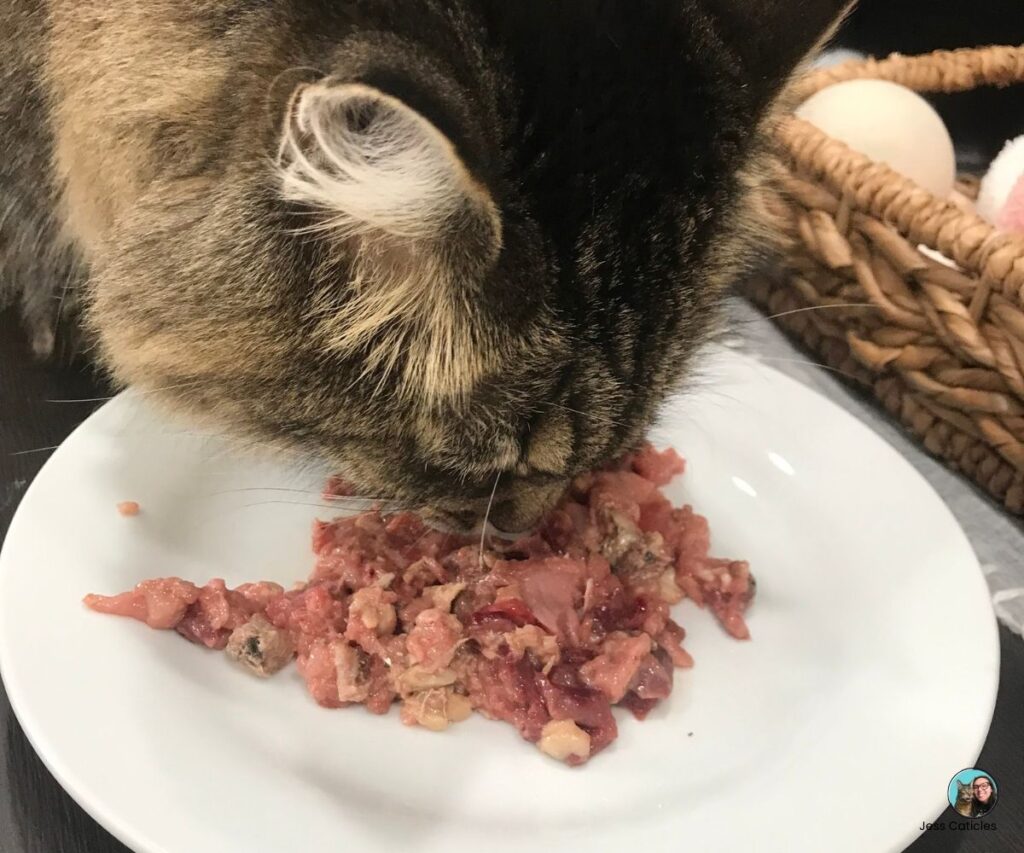
A 2021 study is titled Low Number of Owner-Reported Suspected Transmission of Foodborne Pathogens From Raw Meat-Based Diets.
They received responses from 5,611 raw feeding owners from 62 different countries.
99.45% were not considered to have experienced potential transmission of foodborne pathogens.
And only 31 households (0.55%) were identified as potential cases of transmission.
Another survey from the University of Helsinki proves that cat parents don’t consider raw food to be a significant source of infections.
The 2019 survey received a response from 16,475 households from 81 countries.
“Out of these, only 39 households (0.24%) reported having been contaminated by pet food, and were also able to name the pathogen. The most common pathogens reported were Campylobacteria followed by Salmonella…
…the meat fed to pets had been analysed in only three households (0.02%), identifying the same pathogen as found in the samples taken from the infected individuals…
As well as the 39 households above, 24 households (0.15%) reported a contamination from pet food without being able to name the pathogen causing the symptoms.”
Nutritional imbalances are possible with BARF diets
The second most popular objection and con to BARF diets are nutritional imbalances. This may also stem from confusion when we’re discussing BARF vs PMR for cats.
Kibble and canned foods are labeled “complete and balanced” because manufacturers add amino acids, vitamins, and minerals back in.
The National Library of Medicine states “Compositional analysis of raw meat sources is necessary for proper diet formulation…
The types of meat commonly used in raw meat diets may be deficient in total fat (trimmed muscle meat) and essential fatty acids (trimmings and muscle meats).”
And Dr. Karen Becker says, “An unbalanced raw diet of high-quality fresh meat is in my professional opinion a greater risk to your dog or cat than cheap processed pet food.”
So it’s important to feed a properly balanced raw diet for your cat.
Variety of meat sources is necessary for BARF diets
A solution to the con above is that a variety of meat sources can help balance BARF diets.
Science Daily states “Scientists now assure us that felines need from 5 to 7 different types of prey to fulfill their dietary needs”.
Feline Nutrition Foundation also says that wild cats instinctively seek out nutrients to balance their diet. But indoor cats rely on us to provide the proper balance of nutrients.
Homemade cat food requires a variety of protein sources from meat, organs, and bones. And balance with nutritional supplements when necessary.
Don’t be scared by raw meaty bones! Raw meaty bones benefit our cats way beyond nutrition!
These bones are an important part of an 80 10 10 (slightly modified for cats) diet.
Salmonella associated with BARF diets
I mentioned Salmonella and the health risks above.
But I’d like to dive deeper into actual proof regarding Salmonella contamination and infection.
Human health
The AVMA published a resource paper titled Animal Sources of Salmonellosis in Humans in 2002.
It’s stated, “Although the genus Salmonella consists of more than 2,400 serovars, most human cases of salmonellosis in the United States are caused by 4 serovars.”
Serovars = serotype. A group of closely related microorganisms distinguished by a characteristic set of antigens.
There is a big stink about Salmonella contamination. But only 0.16% of all serotypes of Salmonella contribute to salmonellosis in the US.
Further, they state, “Poultry, meat products, and eggs are most commonly identified as food sources responsible for outbreaks of salmonellosis; however, many other foodstuffs such as ice cream, vegetables and fruits, breakfast cereal, milk, juices, herbs, and spices have also been vehicles of large outbreaks.”
So does this mean we should stop eating because we could potentially be infected?
“Salmonellae are often present in feces excreted by healthy animals and frequently contaminate raw foods of animal origin through fecal contact during production and slaughter…
Animals are a primary reservoir for nontyphoidal salmonellae associated with human infections, and contact with animal feces either directly through animal handling or manure or indirectly through fecal contamination of foods are principal vehicles of human infection.”
So it seems the risk of Salmonella infection is highest with feces.
Solution? Only buy clean meats from trusted sources. Clean and sanitize after handling raw food and scooping the litter box.
Pretty simple, common-sense solution!
Feline Nutrition Foundation states “The risk from pathogens and parasites is minimal if you follow safe-handling procedures and are careful about sourcing the meat and supplements…
It’s the same as you would do with foods intended for your own consumption.”
Simple, common-sense solution verified.
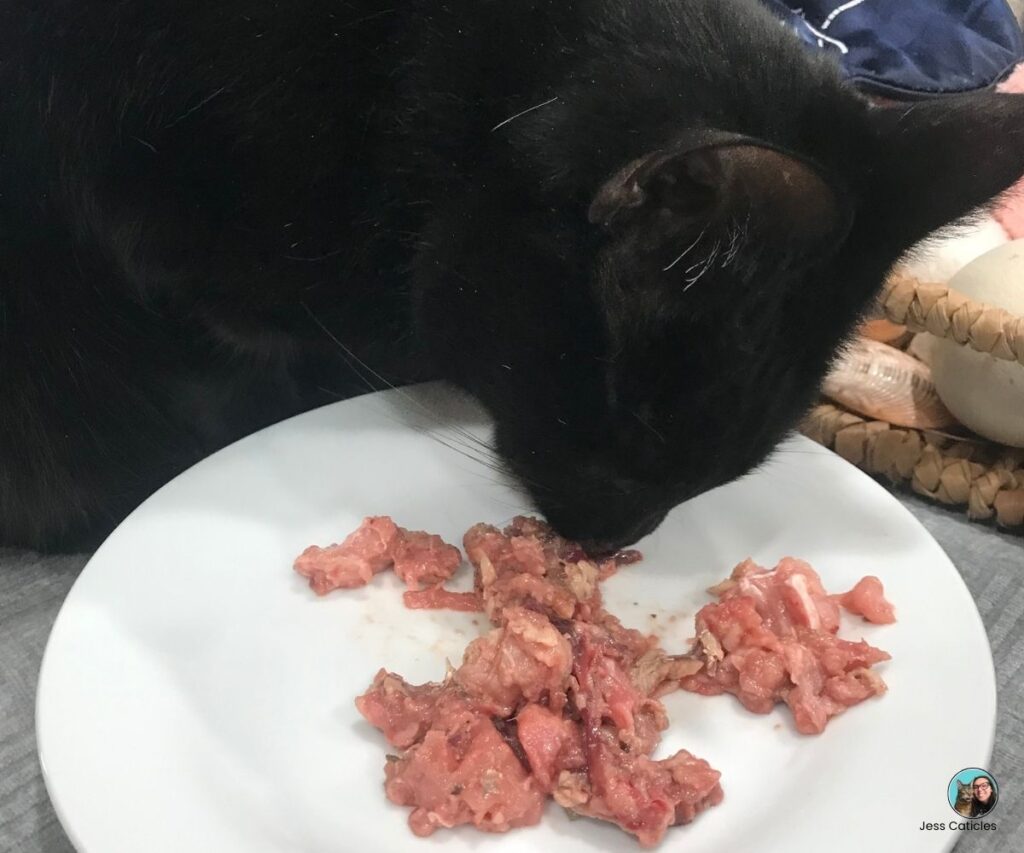
Feline health
Ok so we have a simple solution for humans and preventing Salmonellosis.
Let’s talk about cats regarding Salmonella.
Feline Nutrition Foundation assures that the cat’s stomach is highly acidic. This highly acidic environment protects cats against bacteria and pathogens.
Just think about how your cat licks his butt after he poops.
The cat’s digestive tract is also much shorter. It takes about 13 hours for food to pass through. Humans take 3-4 times that amount to pass food.
So if a healthy cat ingests bacteria, it is likely that the bacteria will pass before it has the chance to overpopulate.
I’d also like to point out that Salmonella contamination exists in kibble too, as noted above.
Personal note: Jericho has been eating a BARF diet since 2018. I started doing full fecal exams yearly in 2020.
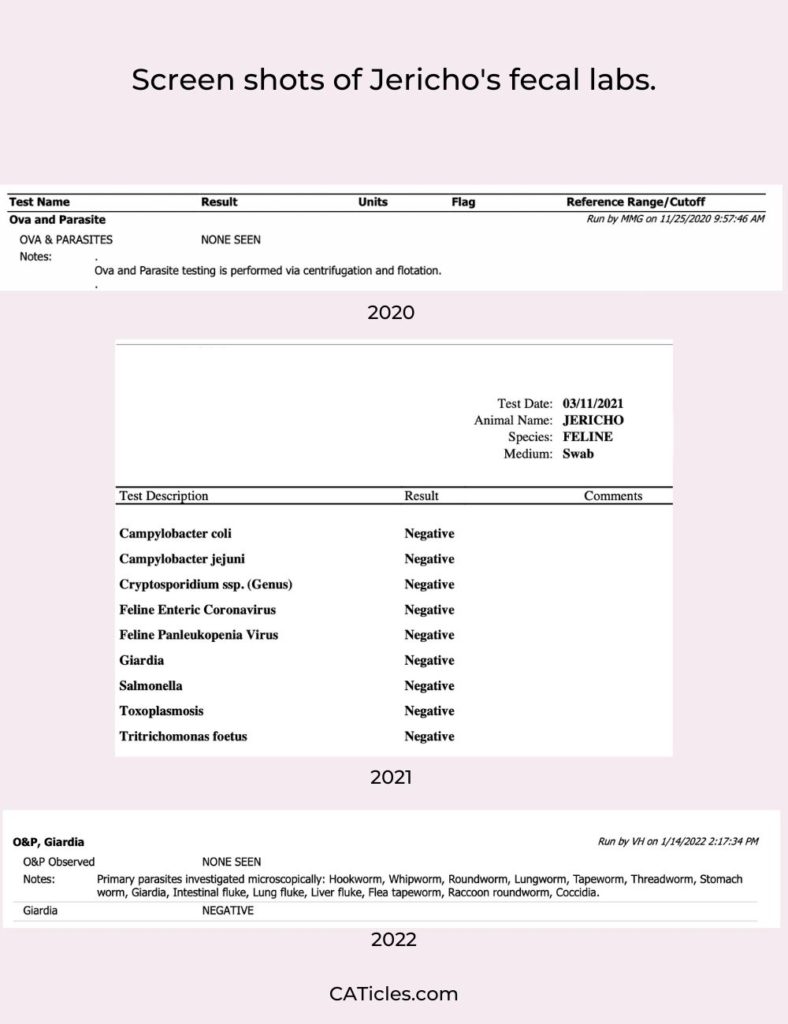
His poops are always negative for bacteria, parasites, and worms. Without the need for prescription medication and dewormers.
Again, it all comes down to how you source and handle the food.
Final thoughts on BARF diet for cats
Statistics and veterinary experience prove that kibble causes obesity and other serious health issues.
There are pros and cons to BARF diets for cats. But the pros far outweigh the cons.
Many holistic vets see tremendous improvements in serious health issues with BARF diets.
The only cons seem to be bacteria risk and nutritional imbalances. These cons are very serious but easily preventable.
Plus, bacteria contamination and imbalances are a risk with kibble as well.
Ready to switch to raw for a happier cat?
Grab my Raw Feeding Blueprint and get the same plan that 564+ cat parents used to switch to a healthy raw diet easily and confidently. Plus 50+ balanced raw recipes, meal prep tips, and so much more!

